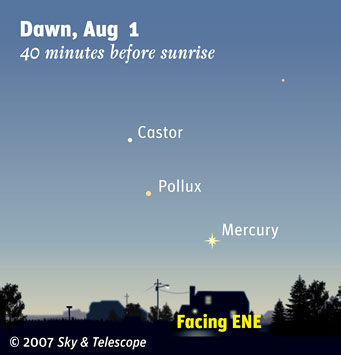
Early risers this week can find Mercury shining above the east-northeast horizon before dawn gets too bright.
Sky & Telescope diagram
If you're an early riser, you can still catch Mercury shortly before sunrise for the next few mornings. After that, it will be lost in the light of dawn.
Wednesday morning is a particularly good time to look, because the innermost planet forms a neat arc with Castor and Pollux, the Twin Stars. Mercury is now blazing at magnitude -1, so it's pretty easy to spot even though it's quite low in the sky. But you may need binoculars to see the Twins, which are only about one-tenth as bright.
If you have trouble finding Mercury, just look for brilliant yellowish Capella halfway up the sky in the east-northeast, with reddish Aldebaran and Mars to its right. Mercury is almost directly below Capella, and you may also be able to make out some of Orion's stars below Aldebaran and Mars. It's quite a lineup!
The keys to a successful sighting are clear skies, an unobstructed eastern horizon, a reliable alarm clock, and plenty of caffeine for those who favor it. Good luck!
 2
2









Comments
Richard Carroll
July 31, 2007 at 3:11 pm
Surely you need an unobstructed EASTERN horizon.
You must be logged in to post a comment.
Tony Flanders
July 31, 2007 at 3:15 pm
Thanks; I've fixed the error. (The original story said that you need an unobstructed western horizon to see Mercury rising.)
You must be logged in to post a comment.
You must be logged in to post a comment.